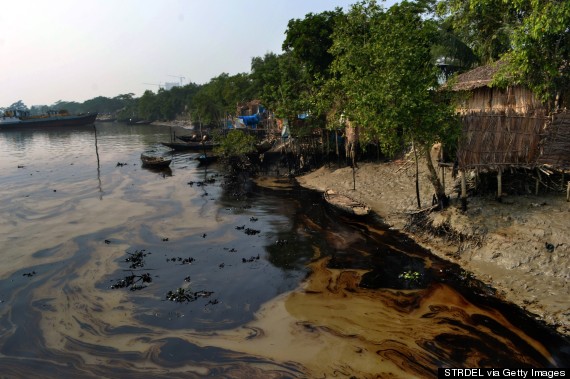What happened?
♣ The Accident – Oil tanker Southern Star -7 carrying 350 tonnes of furnace oil capsized on Sela river . Both tankers were in a no go zone that was declared a sanctuary for endangered dolphins. This lies in the Sunderbans. Despite that, ever since silt had choked the standard shipping route, ships and trawlers have navigated their way through the forest. Tanker was heading to Gopalganj from Khulna industrial port.
♣ Site – Accident happened inside of the three sancturies – Dhanmagri , Chandpal , Dudhmukhi Sanctuary. The Chandpani area, where the accident occurred is strictly out of bounds for ships. IT is roughly 100 kms away from Kolkata port.
♣ Oil slick is is spreading 20 km a day along Sela and Passur rivers and a network of canals.
 What is being done right now?
What is being done right now?
♣ The oil tanker was towed to the shore more than 50 hours after the crash.
♣ Villagers and navy are trying to remove fast spreading oil with traditional method of skimming it off surface with banana leaves and bamboo sticks.
♣ Bangladesh state run petroleum corporation is using buoys to restrict slick. A buoy is a device that floats on water.
♣ Fishermen have been asked to use nets to try stop oil from entering canals.
♣ A ship with dispersant chemicals arrived at the accident site. It will split the oil into droplets and the chemical will increase the density of oil, and then it will be swiped off the surface.
Impact of the Spill
♣ Sunderbans is the world’s largest mangrove ecosystem. It is a UNESCO World Heritage Site. The incident has threatened the survival of multiple species of flora and fauna.
♣ The mangroves go under water twice a day due to tides. Once, water recedes a thick layer of oil carried to forest by tides will cover the vegetation and hamper mangrove plants. Saltwater trees of mangrove ecosystem reproduce from windfall seeds that fall on ground. As oil settles on forest topsoil , seeds that germinate on ground will die. Ergo, Mangroves will not regenrate. The mangroves consist of trees like Sundari , Kewra , Goran , Poshur , Gol.
♣ The seeds also form staple food of Pungash fish which is the food for crocodiles. Thus the food chain will be affected.
♣ Crabs which are in huge number in the forest face biggest threat. If they are affected, dolphins and tigers will be affected.
♣ Irrawaddy and Gangetic Dolphins would be adversely affected because, the thick layer of oil on river surface will drastically reduce the dissolved oxygen, thus affecting the aquatic life.
♣ Mangroves are home to crocodiles, migratory birds, Royal bengal Tiger, Indian otter , spotted deer. Deer survive on the vegetation of mangroves and tigers feed on them. You can understand how the entire food chain will get affected.
♣ The Indian areas at risk could be Mechua and Baghamara on the edge of Bay of Bengal where individual rivers meet the sea.
♣ What faces a direct risk is St Martin’s Island, a coral reef area where there is sensitive ecology. Hilsa fish stock here will be affected. It will hurt the livelihoods of fishermen. Olive Ridley turtles turn to this island for nesting when they migrate from Pacific Ocean and take the eastern coast of Indian Ocean to reach Bay of Bengal and move into the Sunderbans. Oil spill can affect their migration.
Shortcomings in the institutional arrangement
No institutional arrangement is there to tackle an event like this, which can turn into a disaster in an ecologically rich but sensitive region stretching across two countries. No bilateral agreement exists to tackle such crises. The lack of an institutional arrangement impedes quick mobilisation of adequate resources and their scientific deployment. Adequate safety precautions do not exist to regulate maritime traffic in the area. It is imperative that they defined immediately and monitored by the two countries. Tourism in the area should also be regulated, as it can also have an adverse impact on ecology.
See the photo. What extensive damage this can cause to the ecosystem.

I’ve compiled some important and relevant information for you, related to this topic. Please go through this as well.
[su_note note_color=”#d4f780″ text_color=”#000000″ radius=”0″]Bacteria can be used to clean up oil spills in the ocean through bioremediation. Bioremediation is any process that uses decomposers and green plants, or their enzymes, to improve the condition of contaminated environments. Specific bacteria can be used to bioremediate specific contaminants, such as hydrocarbons, which are present in oil and gasoline. The technique was put to use in the very famous oil spill of Gulf of Mexico.[/su_note]
UPSC has had a knack of asking the conservation status of animals. The prominent ones involved in this area include:
- Gangetic Dolphin- Endangered
- Irrawaddy Dolphin – Vulnerable
- Royal Bengal Tiger – Endangered
- Olive Ridley Turtle – Vulnerable
[su_divider divider_color=”#4b692e” link_color=”#0c0b0b” margin=”120″]
Liked the post? Hit kudos 🙂 !
Leave a Reply